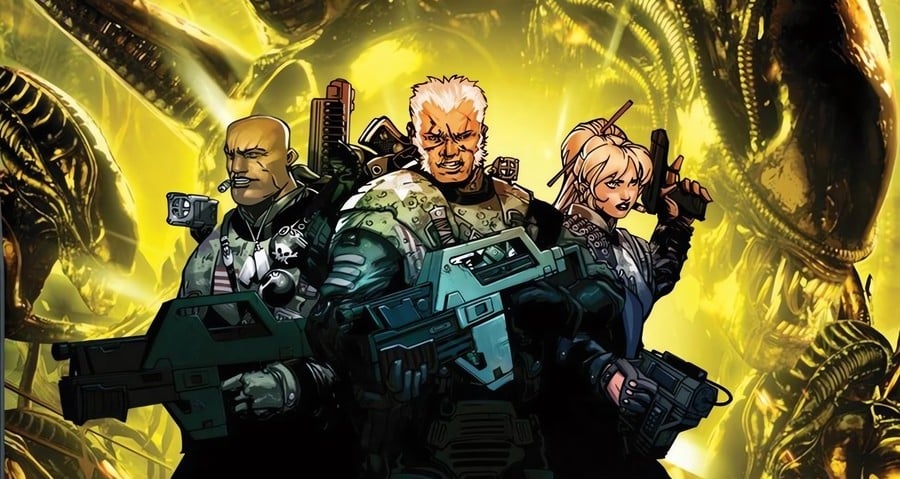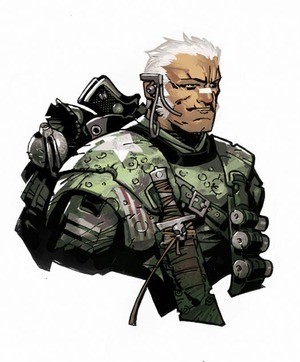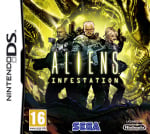
We've had some brilliant video games based on the Alien series of movies, when you stop and really think about it. The first interactive adaption was on the Atari 2600 way back in 1982, and since then, we've been blessed with the likes of Alien 3 (Mega Drive / Genesis), Aliens (Konami, arcade), Alien vs. Predator (Capcom, arcade), Alien Trilogy (PlayStation / Saturn) and, more recently, the terrifying Alien: Isolation, which perhaps got as close as any game to faithfully recreating the tense horror of the original Ridley Scott movie that started the whole series off.
Given how many quality Alien games we've seen, it's remarkable that one of the most acclaimed was released on the humble Nintendo DS – and, rather than imitate the crippling tension of the 1979 film, seeks inspiration from James Cameron's gung-ho 1985 sequel, Aliens. "I grew up loving the Alien films, especially the second one," says WayForward's Adam Tierney, who is currently employed as the company's Director of BizDev and Publishing, but, back in 2011, was the director, co-writer and co-designer on Aliens: Infestation. "I’m sure I’ve seen the first two films at least 20 times each, and I’ve seen everything since then at least a few times as well."
WayForward is a firm which will need little introduction to modern players; it continues to produce some of the finest games in the business, often harnessing the beauty of hand-drawn 2D visuals to create a style which calls back to the past but remains rooted in the present. Prior to working on Aliens: Infestation, the studio had just completed another high-profile project which showcased its talents in the realm of 2D art.

"We had recently finished Contra 4 for Nintendo DS, which was a very well-received pixel run-‘n’-gun game," explains Tierney. "Gearbox and Sega were working on the Colonial Marines game for PC and consoles, and a Nintendo DS game was needed as well. Rather than try and adapt their game to Nintendo DS, Gearbox reached out to WayForward based on our success with Contra. We pitched them our vision, it was signed off on by Gearbox, Sega, and 20th Century Fox, and so we got to develop the game."
Set after the events of the divisive 1992 film Alien 3 – David Fincher's directorial debut – the game saw a group of Marines from the USS Sephora stumble upon the USS Sulaco, the craft which transports series protagonist Ripley between the events of Aliens and Alien 3. The ship is found drifting in space, and Sephora's Colonial Marines board to investigate following the discovery of lifeform readings.
While Aliens: Infestation put WayFoward's 2D talents to excellent use, it was the fact that the game adopted a 'Metroidvania' approach which found the most favour with players at the time of release. The Nintendo DS was hardly short-changed when it came to this genre – Konami released three Castlevania 'Metroidvanias' on the dual-screen handheld – but Aliens: Infestation managed to expand on the template in some interesting ways.

"The usual games proved inspiration, I think – Super Metroid, Symphony of the Night and so on," Tierney says. "What was interesting in addition to that, though, was that we also took influence from modern FPS games at the time, such as Call of Duty 4 and Rainbow Six Vegas. So although the game is structurally a Metroidvania, it’s also got more modern FPS mechanics like taking cover, blind-firing, and tactical reloads, in addition to a more fleshed-out mobility system that allowed for Flashback-style ledge grabs, platform climbing, and so on. We mashed together a lot of different elements to make the game feel as true to the Colonial Marines experience as possible, and I think most of it worked very well together."
Another unique element of the game was its use of permadeath mechanics; only four Marines are under the player's control at any time. Should one of the active Marines fall in battle, they are dead forever and are replaced by one of their squadmates from the Sephora. "Whenever we work on a licensed game, we do a deep, analytical dive on the source material," says Tierney when asked about the use of permadeath in the game. "Rewatching Alien and Aliens during pre-production, it dawned on me for the first time that those films are effectively both slasher films, masquerading as sci-fi and action films, respectively. Both films spend the first half of their runtime making you fall in love with a crew of fiercely memorable characters, then the second half killing them off one by one. So that became our key goal for the game – make the players fall in love with memorable characters, then kill them off."
Finding the right balance for this system was a challenge, but one that WayFoward was keen to take on, as it allowed the game to closely mimic the feel of Cameron's iconic Aliens movie. "In a video game, you don’t really force death on someone," continues Tierney. "So what we did was just balance the game in both difficulty, and in how often new potential recruits pop up, so that the average player would likely lose marines at about the same pace they’d encounter new ones. That way, we could kill off characters that players grew to know and love – as each marine had their own unique name, backstory, dialog, portrait, sprite colour scheme, and so on – and that loss of their favourite character, the fact that they wouldn’t be able to play them again, and had to press on in spite of that tragic loss, would hopefully feel similar to watching characters like Vasquez and Hudson die in the films."

While WayForward's expertise in the realm of 2D art is well known, that doesn't mean that the studio isn't above bringing in external talent to give its projects that extra edge – and in the case of Aliens: Infestation, it turned to notable comic book artist Chris Bachalo. "Bachalo has been my favourite comic artist since I was a teenager, and we got to work with him on an earlier game, X-Men: The Official Game on GBA," explains Tierney. "Chris excels at illustrating unforgettable characters, and it’s hard to picture these marines being nearly as memorable without his involvement in designing and illustrating them. We gave him very broad directions – make one character a synthetic, make another a grizzled old soldier, another kind of gothic, and so on – and he really went wild fleshing them out. Chris even wrote temp names next to each portrait, and a lot of them stuck in the final game. And, of course, the best part is that Chris did the pencils and inks on paper, so when the project wrapped, he was kind enough to sell us most of the original art so that we could gift one drawing each to the game’s key staff. I’d love to work with him again on a future project."
Ironically, the hardest aspect of the game to get right was the titular monster. "The xenomorphs themselves were tricky," Tierney recalls. "You want to make them act like they did in the films, but also make enemies that work well in a side-view platformer video game. And they’re also so different between the films. So we ended up having different types of xeno that were based off the different films. We had a more stealthy, creepy alien that grabbed you from the shadows, based on the Ridley Scott version. We had more agile, dog-legged versions, which were sort of a hybrid of the James Cameron and Paul W. S. Anderson xenomorphs, although they could also run up walls and along the ceiling, like the David Fincher version. And then, of course, we had the Queen Alien, pulled straight from James Cameron’s film."
With its focus on Metroidvania exploration, permadeath and varied host of enemies, Aliens: Infestation certainly packed in a lot of content for a DS release – but it's the narrative that Tierney takes the most pride in today. "You can play as nearly 20 different marines, and each of them has unique dialogue. We basically wrote the game from the perspective of the first marine – John "Duke" Cameron – and then rewrote the dialogue for all the other marines. The main script was written by our game’s lead designer, Cole Phillips, and then myself, Jeff Pomegranate (our producer), and a few others split up the rewrites with Cole. It was a lot of fun to go wild on changing up the dialogue, and that process really informed how we now handle dialogue on subsequent WayForward games, like River City Girls. My favourite character to rewrite was the badass goth chick of the group, Zoe "Cutter" Kennedy. I made some pretty big changes to her script, including a different ending. I have a feeling she was Bachalo’s favourite character, too, since hers was the only original art he didn’t want to part with!"
A critical and commercial success, Aliens: Infestation is the kind of project where everything seemed to come together perfectly – so it's surprising that WayForward hasn't worked with the licence since. "I’d love to work on another Alien game," admits Tierney. "We have discussions occasionally, so anything’s possible. In a way, it’s a shame that it was on Nintendo DS, since those games are a bit tougher to port and adapt to modern consoles, given the second screen and touch input. But I’d love to see the game ported, remade, or get a sequel. I’d love to revisit some of those marines we created in the game, maybe with some new Bachalo art. I miss them."
Ultimately though, even if WayForward doesn't return to the Alien universe, Tierney will at least have a positive experience to look back on. "Aliens: Infestation was one of the first games I directed at WayForward, and to this day, I believe it’s one of our best-received licensed games, among both critics and fans," he concludes. "You never really know when you’re making a game exactly how it’s going to pan out on release. But I was very proud of how it came out, and people still ask us to this day whether we’re ever going to port it or make a sequel."

